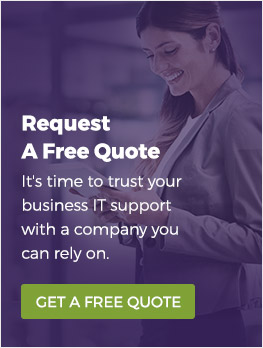As technology becomes more sophisticated, its life cycle seems to get shorter and shorter. We could go into a rant about planned obsolescence, but this blog isn’t the place for that.
Let’s focus on what we can do. Today, we’ll help you understand how End of Service (EOS)—sometimes called End-of-Support—can affect your business. We’ll also talk about End of Life (EOL), a state where a software manufacturer continues to support that software but stops selling it.
Why support ends
Tech manufacturers—especially big ones like Microsoft or Apple—might seem like they have unlimited budgets. They don’t, of course, and even trillion-dollar corporations can’t continue to provide support for every product they release. Tech products, whether an app you use every day or your operating system, need constant support for reasons we’ll address in the next sections.
EOS is a reality that every business has to face. Let’s take a look at some of the reasons you need to account for EOS in your IT budget.
Unsupported software poses security risks
Hackers are a tenacious bunch, and they’re constantly looking for security holes—basically, anywhere they can find them. More often than not, they aren’t looking at individual pieces of software (unless their usage is widespread) but at the frameworks that underpin those pieces of software. To get a better understanding of the type of framework we’re talking about, read our article on the Log4j Bug.
When software is no longer supported, it won’t get vital security updates—including updates to the framework underpinning the software. This makes it easy for hackers to access your networks and data through security holes, some of which are widely known.
Performance issues are common after EOS
One reason that tech companies phase out support is that the hardware their software was built to work on is now antiquated. When Windows XP was developed, they didn’t think that most computers (and the software used on those computers) would have access to several gigabytes of RAM.
Old software doesn’t work well with new hardware. Old hardware doesn’t work well with new software. You’ll need to upgrade both in tandem to avoid performance issues—issues that can cause delays, customer complaints, and other problems.
Your technology may become incompatible
Running cloud accounting software? You might find it stops running properly on older operating systems. Using sophisticated editing software like Adobe Suite? When your hardware gets too old, you may find it stops working altogether.
This may result in you purchasing licences for other software in order to bridge the gap until you’ve updated the incompatible software or hardware. These stopgap measures are both expensive and ineffective. By monitoring for technology that may become incompatible soon, you can upgrade your software and hardware before compatibility issues arise.
You risk running afoul of compliance
Fines, lawsuits, and jail time—these aren’t the first words that come to mind when you think about old technology. Unfortunately, they’re words you have to consider. When you leave valuable data on an app or an operating system that is unsupported, regulators may find that you’ve been negligent in your care of that data. That can lead to serious legal and regulatory repercussions.
Trust Constant C to keep your technology up-to-date
By working with a full-service IT security and support company like Constant C, you can dramatically reduce the risks associated with EOL and EOS. We’re always on the lookout for EOL and EOS, and we’ll be able to update your technology before it stops being supported.


